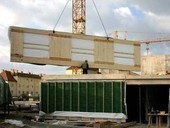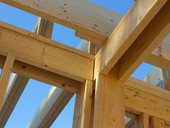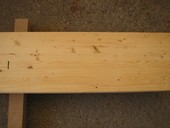Cross laminated timber is likely to happen in the near future, the most important product in solid wood construction in residential and high-rise construction. Depending on the size of the used components and their mutual orientation can produce a wide range of products.
Archiv článků od 25.6.2012 do 3.12.2012
This paper deals with the issue of comparing simulations for steady and unsteady thermal state at the massive structures. In this paper, computer simulations are compared with real measurements and measurements of climatic data. The evaluation showed that the steady-state temperature can be comparing with real model used after the end of the accumulation phase. It is evident that the requirements for the temperature factor of the internal surface of the solid structures, set by legislation, are a safe assumption.
Standards for the building of steel structures in recent years undergone a similar development as the standards for the design of steel structures. System of the Czech standards was supplemented by EN 1090 standard, that became CSN EN 1090. Subsequently, duplicate Czech standards were repealed and replaced by the so-called residual standards, which include provisions that were in the original Czech standards but are not in the standard European.
Video Image Fire Detection is a modern fire detection mechanism of phenomena and processes accompanying fire. Main advantage is the ability and speed of smoke detection, independent of the arrival of the smoke to the sensor. Video Image Fire Detection can achieve higher sensitivity than conventional fire sensors by simultaneously monitoring different parameters in a large area. The article gives basic requirements for Video Image Fire Detector for Automatic Fire Alarm Signaling.
The behaviour of real structures in some cases differs from the structure modeled in computational program. Article deals with the influences that can affect the characteristics of the structure, so that they affect the surface temperature of the structure. In particular, the moisture inside the material and air humidity.
Development of wooden buildings in the Czech Republic is based on the requirement to implement the most low-energy buildings. Still there are many people who are afraid of wooden buildings mainly because of their misconceptions about their behaviour under fire. But the truth is that in a fire wood doesn’t lose its rigidity and strength, and the remaining sections of wood elements are also able to carry the load.
The behaviour of real structures in some cases differs from the structure modeled in computational program. Article deals with the influences that can affect the characteristics of the structure, so that they affect the surface temperature of the structure. In particular, the moisture inside the material and air humidity.
The paper includes conclusions from evaluation of results obtained from long-term measuring of innovative types of timber structures. Based on the results of measurements of vertical and horizontal deformation components it is possible to analyze the real behaviour of structures in given conditions. By assessing deformations in various stages, including particularly external and internal environment temperatures, relative air humidity and moisture content of wood, decisive parameters for real structure behaviour can be established.
The Lower House of Parliament passed an amendment to the Construction Act. It’s the tenth one over 7 years, when the new Construction Act came into effect. Must admit that sometimes this one of the fundamental laws was amended as a part of adoption of another act or amendment of another law. This last one is the most important amendment of the previously adopted amendments.
This paper is based on the results of theoretical, implementation and realization work of load-bearing systems for timber frame houses. The paper contains the conclusions from designing and realization of some selected structures especially of the mountain hotel which is being built in the Krkonoše Mountains (Czech Republic).
Rating of LEED has clearly favored FSC certification (Forest Stewardship Council) over the other, let's say competing types of national and international certification of wood. Critics point to the FSC for example, that in principle there is no clearly identified reason for the creation of an evaluation standard.
The object of this work is a numerical analysis of the behavior of wood-concrete composite ceiling structure, consisting of concrete slab and wooden beams of glued laminated timber. The main objective is to explore the use of concrete slabs, which assists with wooden beams, and using models in ANSYS to investigate its behavior in the load floor construction. The accuracy of numerical analysis of wood-concrete structure fully depends on the material models. Therefore the material models will be later verified by experimental results.
In addressing the fire safety of buildings it is necessary to know the value of fire resistance of building products and constructions of building and to design constructions, which meet required fire resistance values. It is necessary to distinguish two categories of elements: building products and construction.
Determination of the development of fire in the compartment with subsequent detection of temperature in different parts of the structure requires knowledge of many parameters. The most important step is to determine the design fire scenario that matches the extraordinary fire situation best. The design of fire can describe the temperatures in the fire department and determine the heat transfer in structure. Let's look at several models and the thermal and mechanical load of structures.
Changes in humidity of original wooden structure after the additional thermal insulation of building
Thermal insulation of prefabricated panel buildings is shifting to residential houses built on a brick in at the end of the 19th century and the beginning of the 20th century. These houses usually have an unheated basement with brick arches or wooden beam ceiling. Insulation of envelope and leaving the original heating system leads to a change in the internal climate and causing secondary faults.
Fire engineering is a way to define the requirements of fire safety at risk, complex and unusual structures. It consists in a specific risk assessment of fire safety conditions in a different ways from those of the procedure prescribed in Czech technical standards under § 99 of Act No. 133/1985 Coll. for fire protection. Notes on the standards will be presented in three parts. Part Three: Another standards.
The paper deals with optimizing the thickness and material of the reinforcing plates used for beams of glued laminated timber. It was first mapped in detail twenty unreinforced beams of glued laminated timber, where the great attention paid to accurately determine the elastic modulus in the direction of fibers of individual segments of blades and their localization in the beam.
Fire engineering is a way to define the requirements of fire safety at risk, complex and unusual structures. It consists in a specific risk assessment of fire safety conditions in a different ways from those of the procedure prescribed in Czech technical standards under § 99 of Act No. 133/1985 Coll. for fire protection. Notes on the standards will be presented in three parts. Part Two: Industrial buildings.
zpět na aktuální články



















